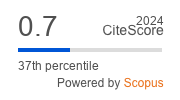The Surgical outcomes of fundus-first technique in lowering the rate of bile duct injuries and bleeding during open cholecystectomy that facing intraoperative difficulties: A single-center prospective study
The surgical outcomes of open fundus-first cholecystectomy technique.
DOI:
https://doi.org/10.47723/kcmj.v19i1.963Keywords:
Fundus-first cholecystectomy, Scleroatrophic gallbladder, Open intraoperative difficulties, SudanAbstract
Background: The problem of difficult gallbladder is not clearly defined and associated with real missing of therapeutic approaches that decreased morbidity. Moreover, the difficult gallbladder was reported as a contributing risk factor for biliary injury due to raised difficulty in surgical dissection within Calot’s triangle. The aim of this study is to determine the surgical outcomes of the open fundus-first cholecystectomy in lowering the rate of lethal intraoperative risks.
Subjects and Methods: Our prospective study conducted during the period of January 2019 to December 2022 at Ibn Sina specialized hospital, Khartoum, Sudan, for two hundred and fifty-three patients underwent elective open fundus-first cholecystectomy for intraoperative difficulties.
Results: the majority of cases had long-standing cholelithiasis with intraoperative difficulties revealed by pre-operative TUS and MRCP which required open fundus-first cholecystectomy in 173 (68.4%) of patients, (P-value <0.05). The operative surgical time was 120 minutes in 103 patients (40.7%), (P-value <0.05). During open cholecystectomy, variable intraoperative difficulties were found in all patients, (P-value <0.05) and were divided into: (A) Contracted intra-hepatic gallbladder seen in 157 (62.1%) of cases; (B) Distorted anatomy within Calot's triangle seen in 135 (53.4%) of patients; and (C) Intraoperative bleeding from the liver bed was observed as bloody oozing form in 150 (59.3%) of cases. Our patients had minimal postoperative complications like mild wound infection in 8 (3.2%) of cases and mortality rate was zero.
Conclusions: There is a need for appropriate therapeutic and preventive strategies in healthcare systems for safe dealing with difficult cholecystectomy. Unclear anatomy due to severe inflammatory dense adhesions at Calot’s triangle and CBD stones needing difficult surgeries are the most important limiting factors for fundus-first laparoscopic cholecystectomy. Hence, we humbly recommend an open approach of fundus-first cholecystectomy as safe surgical option to reduce the incidence of bile duct injuries and intra-operative bleeding.
Downloads
Published
Issue
Section
License
Copyright (c) 2023 AL-Kindy College Medical Journal

This work is licensed under a Creative Commons Attribution 4.0 International License.














